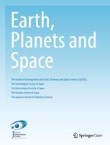Earth, Planets and Space welcomes submissions to this special issue on “DynamicEarth: Earth’s interior, surface, ocean, atmosphere, and near space interactions”.
Variations in Earth’s interior, atmosphere, oceans, and near-Earth space manifest in global fields such as in Earth’s magnetic and gravity fields. An interdisciplinary approach is thus most effective to best exploit new observations and advanced modelling capabilities. The Priority Programme 1788 DynamicEarth funded by the German Research Foundation (DFG) between 2015-2021 has established an international research framework for gravity, geomagnetism, and space and atmospheric sciences to tackle their intra-disciplinary questions. This special issue solicits contributions that exploit data from dedicated satellites in low Earth orbit, such as Swarm, GRACE/-FO, among others, and addresses studies based on ground-based observations and simulations that concerns one or more of these research areas and their connections. Contributions supported by the DynamicEarth programme or by other research programmes that tackle these areas are welcome.
Submission Instructions
Before submitting your manuscript, please ensure you have carefully read the submission Guidelines Earth, Planets and Space. The complete manuscript should be submitted through the Earth, Planets and Space submission system. To ensure that you submit to the correct special issue please select the appropriate special issue in the drop-down menu upon submission. In addition, indicate within your cover letter that you wish your manuscript to be considered as part of the special issue on 'DynamicEarth: Earth’s Interior, Surface, Ocean, Atmosphere, and Near Space Interactions'. All submissions will undergo rigorous peer review and accepted articles will be published within the journal as a collection.
Deadline for submissions: 31 March 2022
Lead Guest Editor
Claudia Stolle, Leibniz Institute of Atmospheric Physics (IAP), Kühlungsborn, Germany
Guest Editors
Julien Baerenzung, University of Potsdam, Germany
Elena Kronberg, Ludwig-Maximilian-University Munich, Germany
Jürgen Kusche, Universität Bonn, Germany
Huixin Liu, Kyushu University, Japan
Hisayoshi Shimizu, Earthquake Research Institute, University of Tokyo
Rapid publication: Online submission, electronic peer review and production make the process of publishing your article simple and efficient
High visibility and international readership in your field: Open access publication ensures high visibility and maximum exposure for your work - anyone with online access can read your article
No space constraints: Publishing online means unlimited space for figures, extensive data and video footage
Authors retain copyright, licensing the article under a Creative Commons license: articles can be freely redistributed and reused as long as the article is correctly attributed
For editorial enquiries please contact: eic@earth-planets-space.org.
Sign up for article alerts to keep updated on articles published in Earth, Planets and Space - including articles published in this special issue!


















